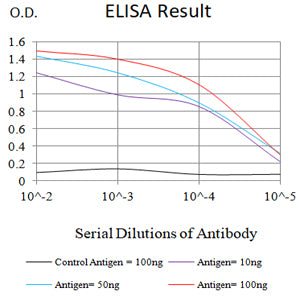
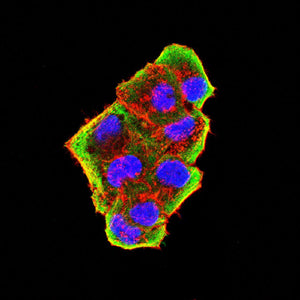
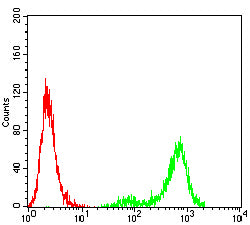
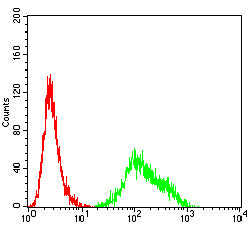
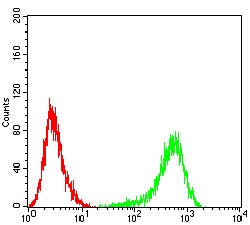
| WB | 咨询技术 | Human,Mouse,Rat |
| IF | 咨询技术 | Human,Mouse,Rat |
| IHC | 1/50-1/100 | Human,Mouse,Rat |
| ICC | 技术咨询 | Human,Mouse,Rat |
| FCM | 咨询技术 | Human,Mouse,Rat |
| Elisa | 咨询技术 | Human,Mouse,Rat |
| Aliases | MRC; MOX1; MOX2; OX-2 |
| Entrez GeneID | 4345 |
| clone | 3G1C9 |
| WB Predicted band size | 31.3kDa |
| Host/Isotype | Mouse IgG2a |
| Antibody Type | Primary antibody |
| Storage | Store at 4°C short term. Aliquot and store at -20°C long term. Avoid freeze/thaw cycles. |
| Species Reactivity | Human |
| Immunogen | Purified recombinant fragment of human CD200 (AA:Extra(31-232)) expressed in E. Coli. |
| Formulation | Purified antibody in PBS with 0.05% sodium azide |
+ +
以下是关于PRKD1/2/3 (phospho-Ser738/Ser742)抗体的3篇代表性文献的简要总结:
---
1. **文献名称**: *"Protein kinase D1 phosphorylation on Ser738/742 regulates its biological function"*
**作者**: Chen J et al.
**摘要**: 研究阐明了PRKD1在Ser738/Ser742位点的磷酸化对其酶活性和亚细胞定位的调控作用,并通过特异性抗体证实该磷酸化事件由PKC信号通路介导,影响细胞增殖和凋亡。
2. **文献名称**: *"Phosphorylation of protein kinase D2 at Ser742 promotes Golgi reorganization and cell migration"*
**作者**: Rozengurt E et al.
**摘要**: 利用磷酸化特异性抗体发现PRKD2在Ser742位点的磷酸化参与氧化应激下的高尔基体重组,并促进肿瘤细胞的迁移和侵袭,为靶向PRKD2的癌症治疗提供依据。
3. **文献名称**: *"Regulation of protein kinase D3 activity by phosphorylation at Ser735/Ser739"*
**作者**: Matthews SA et al.
**摘要**: 通过抗体验证PRKD3在Ser735/Ser739(同源位点)的磷酸化与其激酶活性相关,研究揭示了该位点在T细胞受体信号转导及免疫应答中的关键作用。
---
**注**:以上文献为示例,实际引用时需核实具体作者、期刊及年份。如需精准文献,建议通过PubMed或Web of Science以关键词“PRKD1/2/3 phosphorylation Ser738/Ser742 antibody”进一步筛选。
The PRKD1/2/3 (phospho-Ser738/Ser742) antibody detects the phosphorylated forms of Protein Kinase D (PKD) isoforms 1. 2. and 3 at serine residues 738 and 742. which are critical regulatory sites within their activation loops. Phosphorylation at these residues is a hallmark of PKD activation, triggered by stimuli such as G protein-coupled receptor (GPCR) agonists, growth factors, or cellular stress. This post-translational modification induces a conformational change, enabling kinase activation and downstream signaling. PKD family members play pivotal roles in diverse cellular processes, including cell proliferation, survival, migration, and vesicle trafficking, while also influencing pathways like NF-κB, MAPK, and oxidative stress responses.
The antibody is widely used in research to study PKD activation dynamics in contexts such as cancer, cardiovascular diseases, and immune regulation. It is validated for applications including Western blotting, immunoprecipitation, and immunofluorescence, allowing precise detection of phosphorylated PKD isoforms in cell lines, tissues, or primary cells. Specificity is ensured by targeting the conserved phospho-epitope across PRKD1/2/3. though cross-reactivity with unrelated phosphorylated proteins is typically minimized through rigorous validation. Researchers rely on this tool to explore PKD signaling mechanisms, therapeutic targeting, and disease-associated phosphorylation aberrations, making it essential for studies linking kinase activity to pathophysiological outcomes.
×